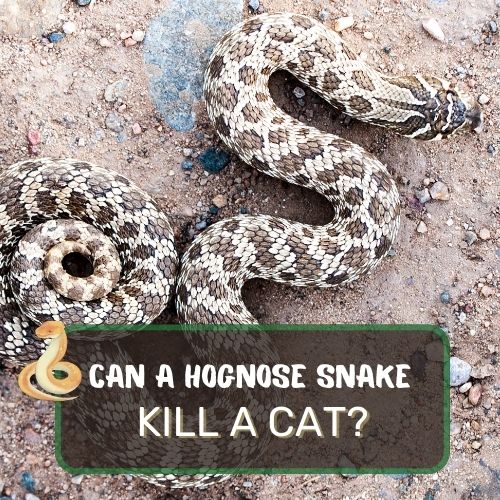
In this article, we delve deep into the world of hognose snakes, their venom, and the potential interactions with our feline friends.
We’ve examined factors like the snake’s behavior, the potency of its venom, and real-life scenarios to provide a comprehensive answer.
By the end of this read, you’ll have a clear understanding of the dynamics between these two creatures and the precautions to take.
So, whether you’re a curious cat lover or a budding herpetologist, this article promises insights that will both educate and fascinate.
Table of Contents
Can a Hognose Snake Kill a Cat? Short Answer
Hognose snakes are known for their unique upturned snouts and are generally considered harmless to humans. When it comes to cats, the risk is minimal. While hognose snakes do produce a mild venom, it’s primarily effective against their typical prey, like amphibians and small lizards. If a hognose snake were to bite a cat, the most likely outcome would be localized swelling and discomfort, similar to a bee sting.
However, it’s essential to note that negative interactions between cats and hognose snakes are rare. In most scenarios, the snake poses little to no threat to a cat’s life.
Cats vs. Hognose Snakes: The Likely Scenarios

Ah, the age-old question of what happens when our feline friends meet the unique and intriguing hognose snake. It’s a topic that’s piqued the curiosity of many pet owners, and today, we’re diving deep into the heart of this mystery.
So, grab your detective hat, and let’s unravel this together!
The Natural Behavior of Cats and Their Curiosity Towards Moving Objects
Anyone who’s spent even a smidgen of time with a cat knows they’re curious creatures. Dangle a piece of string, and they’re on it like white on rice. Their predatory instincts are hardwired, and anything that moves can become an object of fascination.
This includes, you guessed it, snakes.
Now, imagine a scenario: Your cat is lounging in the garden, soaking up the sun, and suddenly spots a hognose snake slithering by. The snake’s unique upturned snout and movement are bound to catch your cat’s attention.
And just like that, the game of cat and… snake, begins.
How Hognose Snakes Typically React When Threatened
Hognose snakes aren’t your typical aggressive reptiles. In fact, they’re more of the drama queens of the snake world.
When threatened, instead of striking, they often play dead, rolling onto their backs and even sticking out their tongues for added effect. It’s a performance worthy of an Oscar!
But let’s not forget about their mild venom. While it’s primarily designed to subdue their prey, like frogs and small lizards, it’s not potent enough to cause severe harm to larger animals, including cats.
So, if your cat does get a little too curious and receives a bite, it’s more likely to be a shock for the cat rather than a life-threatening situation.
The Potential for Negative Interactions and the Likely Outcomes
Given the hognose snake’s penchant for theatrics and the cat’s natural curiosity, there’s potential for some dramatic encounters. But here’s the thing: most of these interactions are more comical than dangerous.
For instance, if a cat pounces on a hognose snake, the snake might just “play dead,” leaving the cat utterly confused. It’s like the universe’s way of saying, “Gotcha!”
However, on the off chance that the snake does bite, the cat might experience localized swelling, much like a bee sting. It’s uncomfortable, sure, but not deadly.
And let’s be real, after such an encounter, it’s more likely that the cat will think twice before approaching another snake.
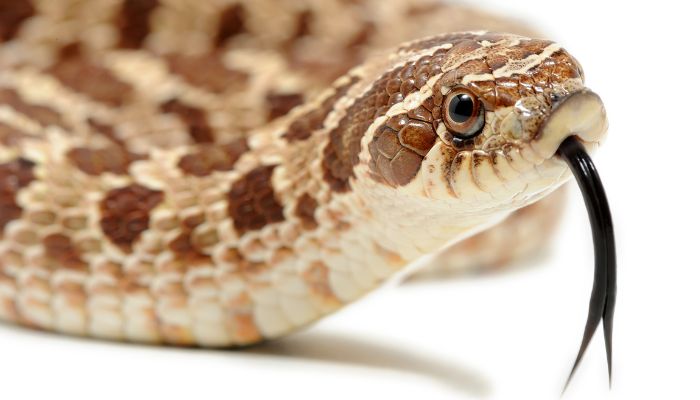
The Venom of the Hognose Snake
When it comes to snakes, venom is often the first thing that springs to mind. But with hognose snakes, things are a tad different. Let’s dive into the world of hognose venom and debunk some myths.
Clarification that Hognose Venom is Harmless to Humans Unless There’s an Allergy
First things first, hognose snakes aren’t the villains they’re sometimes made out to be. Their venom is relatively mild, especially when compared to some of their slithery counterparts.
For most humans, a bite from a hognose snake would be inconsequential. However, just as some people are allergic to peanuts or shellfish, there’s a small fraction of the population that might have an allergic reaction to the venom.
It’s always a good idea to be cautious, but widespread panic? Totally unnecessary.
Comparison of Hognose Venom to a Bee Sting in Terms of Potency and Likelihood of Reaction
To put things into perspective, think of a bee sting. For many, it’s a sharp pinch followed by some temporary discomfort. Similarly, a hognose snake’s bite is often compared to a bee sting in terms of its potency.
The likelihood of a severe reaction is minimal, but again, those with allergies should be wary.
Explanation of How Hognose Venom is Tailored More to Amphibians and Small Lizards
Nature is fascinating, isn’t it? Hognose snakes have venom that’s specifically tailored to their diet. Their primary prey includes amphibians and small lizards. The venom works effectively on these creatures, immobilizing them swiftly.
It’s a classic case of nature ensuring predators have the right tools for their dietary needs.
Behavior and Temperament of Hognose Snakes
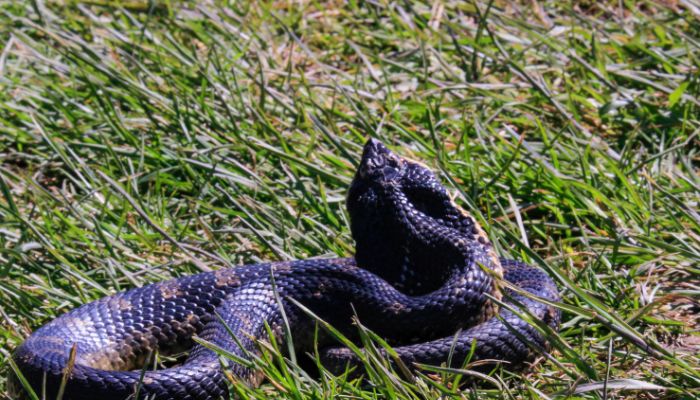
Moving on from venom, let’s delve into the behavior and temperament of these intriguing reptiles.
Their Diurnal Nature
Unlike some of their nocturnal cousins, hognose snakes are diurnal. This means they’re active during the day, basking in the sun, hunting, and going about their snakey business. So, if you ever come across one during your daytime hikes, don’t be surprised!
The Eastern Hognose’s Unique Behavior of Playing Dead
One of the most fascinating behaviors of the eastern hognose snake is its ability to play dead. When threatened, instead of slithering away or getting aggressive, it flips onto its back, opens its mouth, and plays dead.
It’s a dramatic performance, and more often than not, it deters potential predators. Talk about a unique survival tactic!
Their General Docility and Rare Instances of Aggression
Hognose snakes are generally docile creatures. They’re not out to pick fights or cause trouble. In fact, instances of aggression are rare. Most of the time, if they feel threatened, they’d rather put on their death act or simply slither away.
It’s this gentle nature that has made them increasingly popular as pets among reptile enthusiasts.
Safety Precautions for Pet Owners
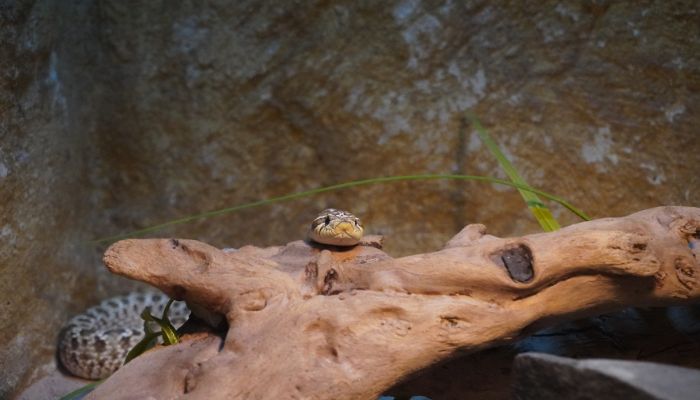
Ah, the joys of pet ownership! From the purring of a cat to the mesmerizing movements of a hognose snake, pets bring a unique kind of magic into our lives.
But with great joy comes great responsibility, especially when you’re juggling the needs of both a feline and a reptile. Let’s dive into some essential safety precautions to ensure harmony in a multi-pet household.
The Importance of Keeping Cats and Hognose Snakes Separated
Cats, with their innate curiosity, are often drawn to anything that moves, and a slithering snake is no exception. On the other hand, hognose snakes, while generally docile, can feel threatened by a looming feline. It’s a recipe for potential conflict.
Keeping them separated isn’t just about preventing physical harm; it’s about ensuring both animals feel safe and stress-free in their environment. Remember, a stressed pet is neither happy nor healthy.
Tips for Ensuring the Snake’s Enclosure is Secure
A secure enclosure is the first line of defense in preventing any unwanted encounters. Here are some tips:
- Choose the Right Enclosure: Invest in a high-quality terrarium or vivarium with a lockable lid.
- Regular Checks: Periodically inspect the enclosure for any wear and tear, especially around the edges and the locking mechanism.
- Location Matters: Place the enclosure in a low-traffic area where it’s less likely to be accidentally bumped or knocked over.
- Weight it Down: Consider placing a weight or a secure latch on the lid to prevent any sneaky escapes.
What to Do if the Snake Escapes
First, don’t panic. Remember, hognose snakes aren’t aggressive by nature.
- Limit the Search Area: Close doors and windows to confine the snake to one area.
- Look Low: Snakes are more likely to be found hiding in dark, cool places. Check under furniture, behind appliances, and inside shoes.
- Use Prey as Bait: Consider placing a small, warm rodent (like a mouse) in the middle of the room to lure the snake out.
- Safety First: When you find the snake, handle it gently using snake-handling tools or thick gloves, and return it to its enclosure.
What to Do if Your Cat and Snake Do Come into Contact
If the unthinkable happens and your cat and snake cross paths:
- Stay Calm: Your pets will pick up on your energy. Panicking can escalate the situation.
- Separate Them Gently: Use a broom or a long object to gently guide them away from each other.
- Check for Injuries: Examine both your cat and snake for any signs of bites or scratches.
- Consult a Vet: Even if there are no visible injuries, it’s a good idea to consult a vet, especially if there’s a chance your cat was bitten.
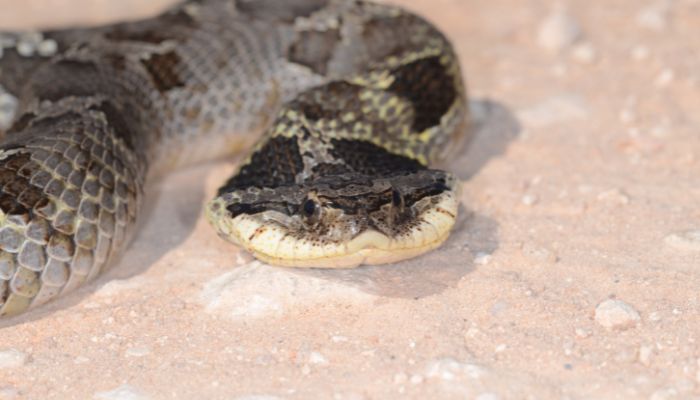
While cats and hognose snakes can coexist under one roof, it requires vigilance, preparation, and a good dose of common sense. With the right precautions, you can ensure a peaceful and safe environment for all your pets.
Final Word
In your journey through this article, you’ve navigated the intricate dynamics between hognose snakes and cats.
You’ve discovered that while hognose snakes possess venom, its potency is tailored more for their prey, like amphibians and small lizards, rather than larger animals such as cats.
You’ve also learned about the natural behaviors of both these creatures and the importance of ensuring their safety in shared environments.
Understanding these nuances is crucial, especially if you’re a pet owner or someone considering introducing these animals into your home. Knowledge, as they say, is power.
By being informed, you’re better equipped to create a harmonious environment for all your pets, ensuring their well-being and happiness.
As you move forward, remember that the natural world is full of wonders and complexities. Every creature, big or small, has its unique role and characteristics. Embrace this knowledge, and let it guide you in making informed decisions.
You’re on the right path, and with continued curiosity and care, you’ll foster a safe and understanding space for all the animals in your life. Keep up the great work!
FAQ
Let’s address some of the most frequently asked ones to shed light on this intriguing topic.
Is a Cat Immune to Snake Venom?
No, cats are not immune to snake venom. While they might have a higher tolerance than some other animals due to their size and physiology, they can still be affected by venomous snake bites. The reaction largely depends on the type of snake, the amount of venom injected, and the cat’s overall health.
Are Hognose Snakes Safe Pets?
Absolutely! Hognose snakes are known for their docile nature and are often recommended for beginner reptile enthusiasts. While they do produce venom, it’s mild and primarily effective against their prey. With proper care and handling, they make fascinating and safe pets.
How Potent is Hognose Venom?
Hognose venom is relatively mild, especially when compared to venom from other snakes. It’s tailored to subdue their primary prey, like amphibians and small lizards. For larger animals and humans, the venom is usually not a significant threat.
What Happens if a Cat is Bitten by a Venomous Snake?
If a cat is bitten by a venomous snake, it may show signs like swelling, pain, lethargy, and difficulty breathing. Immediate veterinary attention is crucial. The vet might administer antivenom, pain relief, and other supportive treatments. It’s essential to keep the cat calm and try to identify the snake, as this can help in treatment.

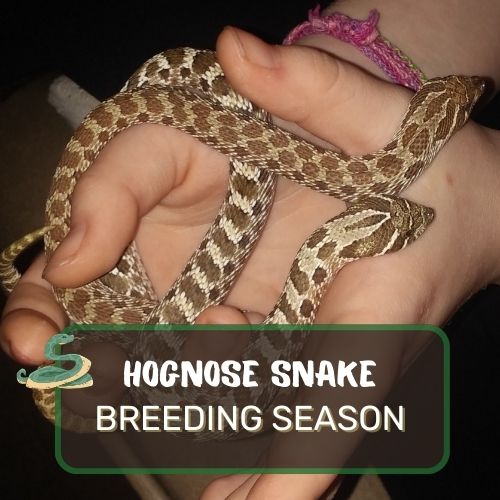
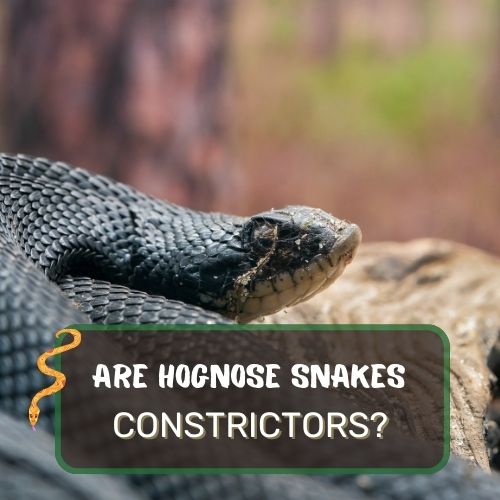
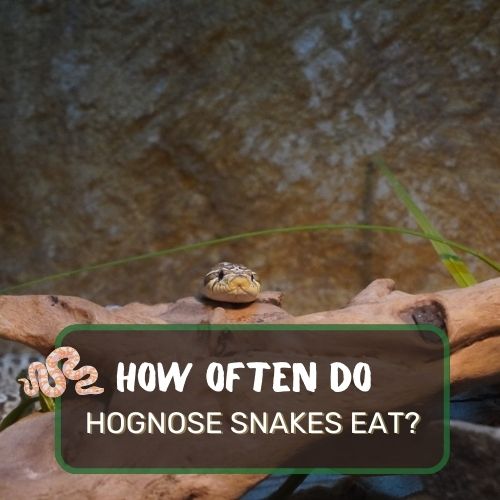
0 Comments